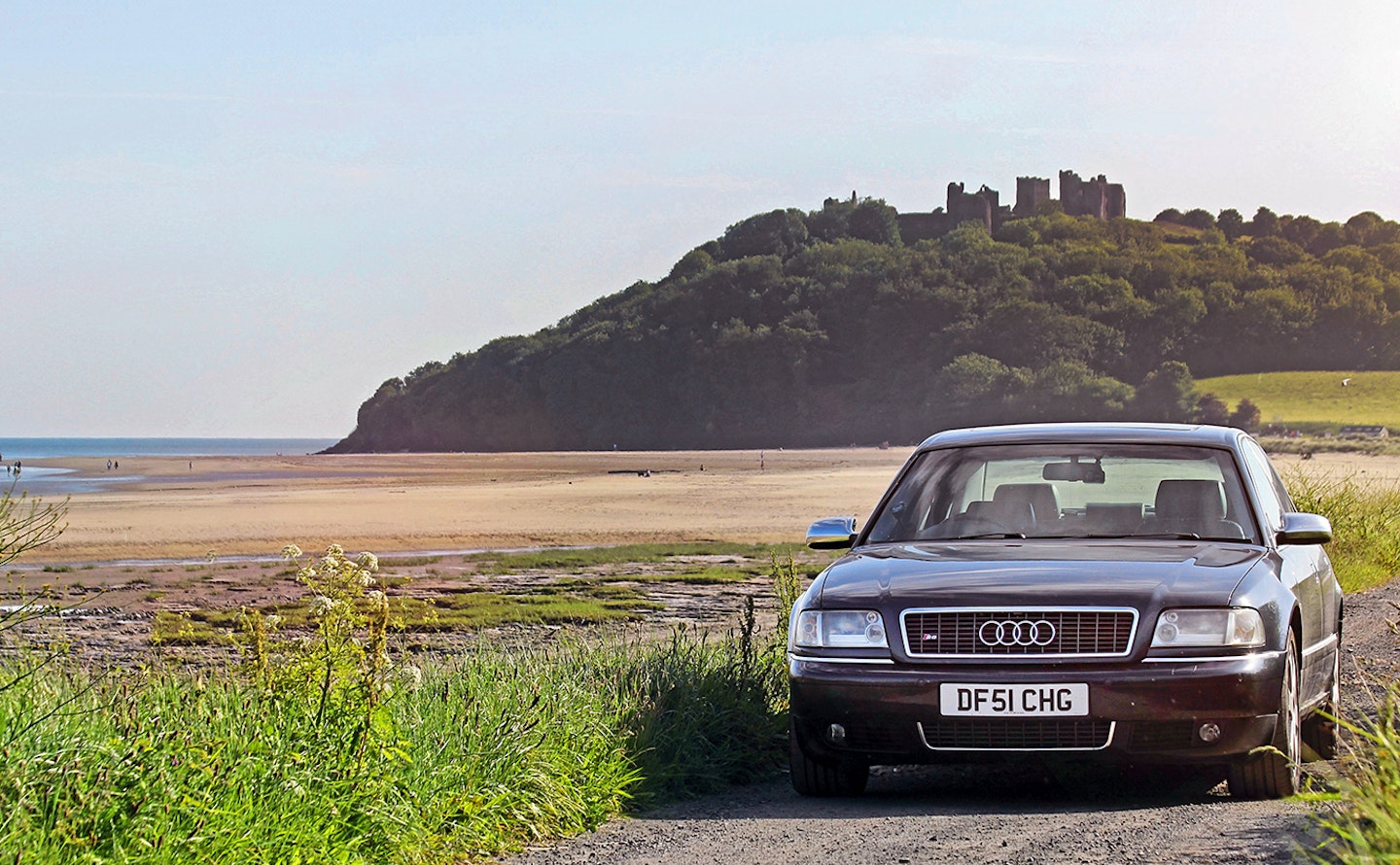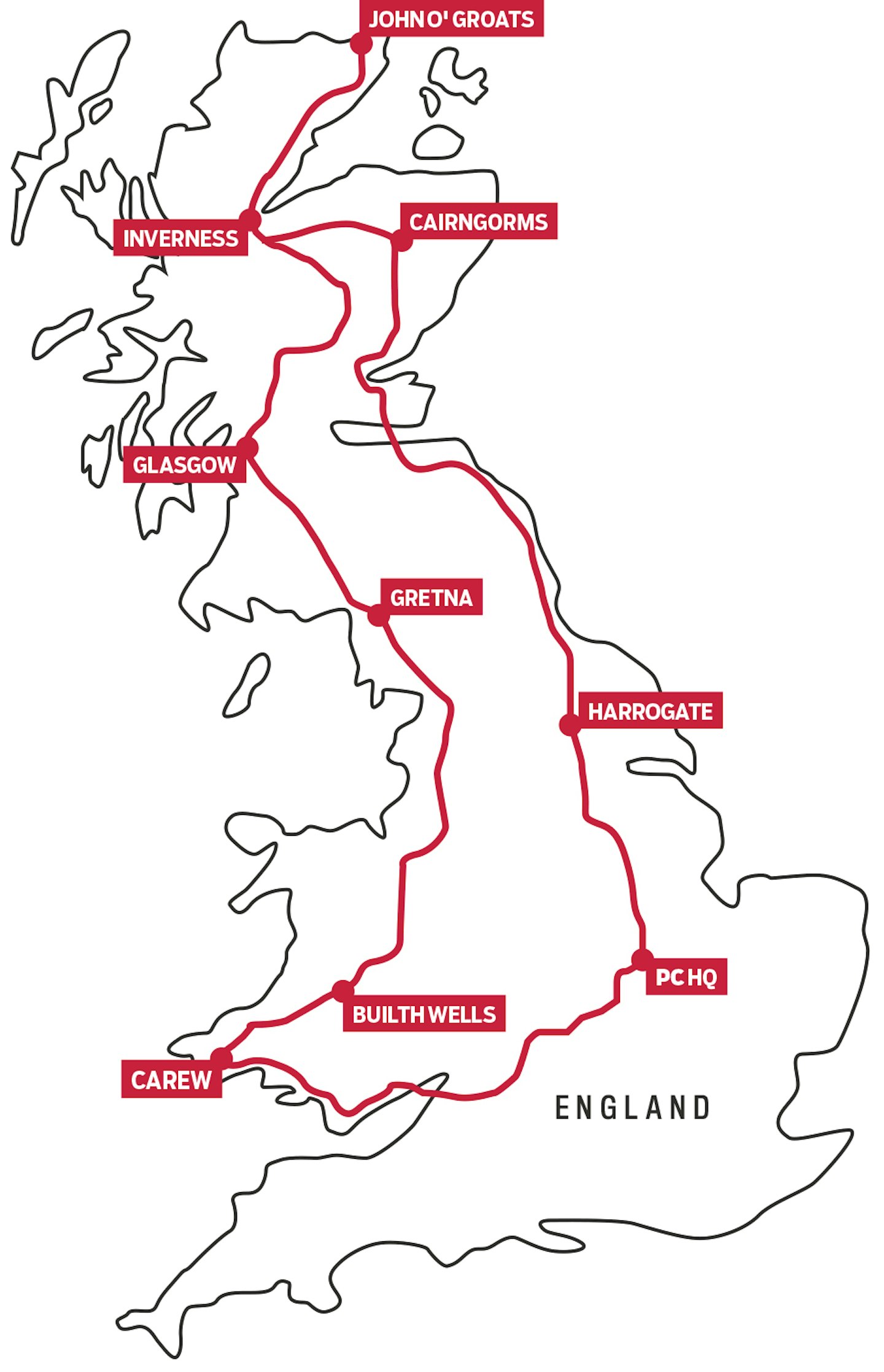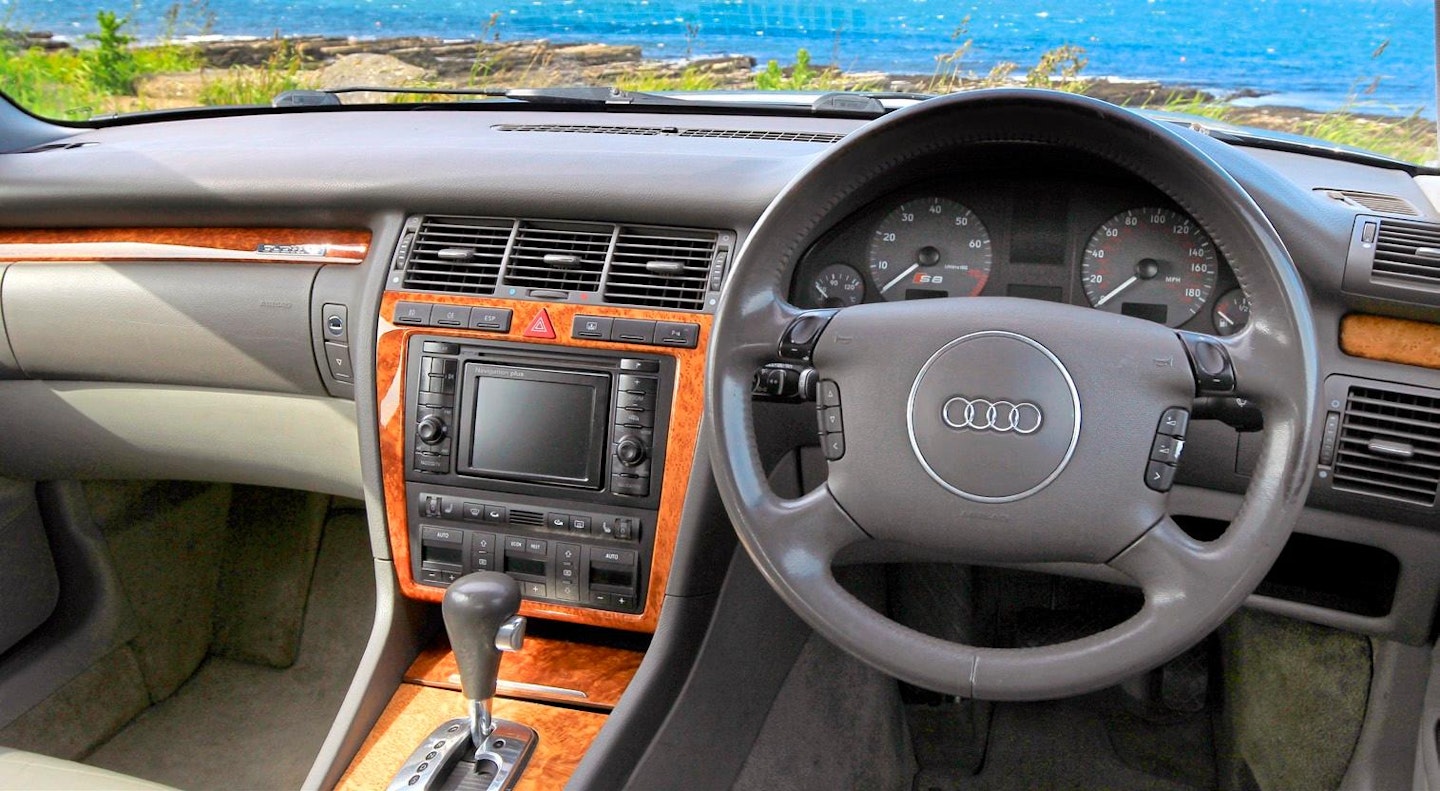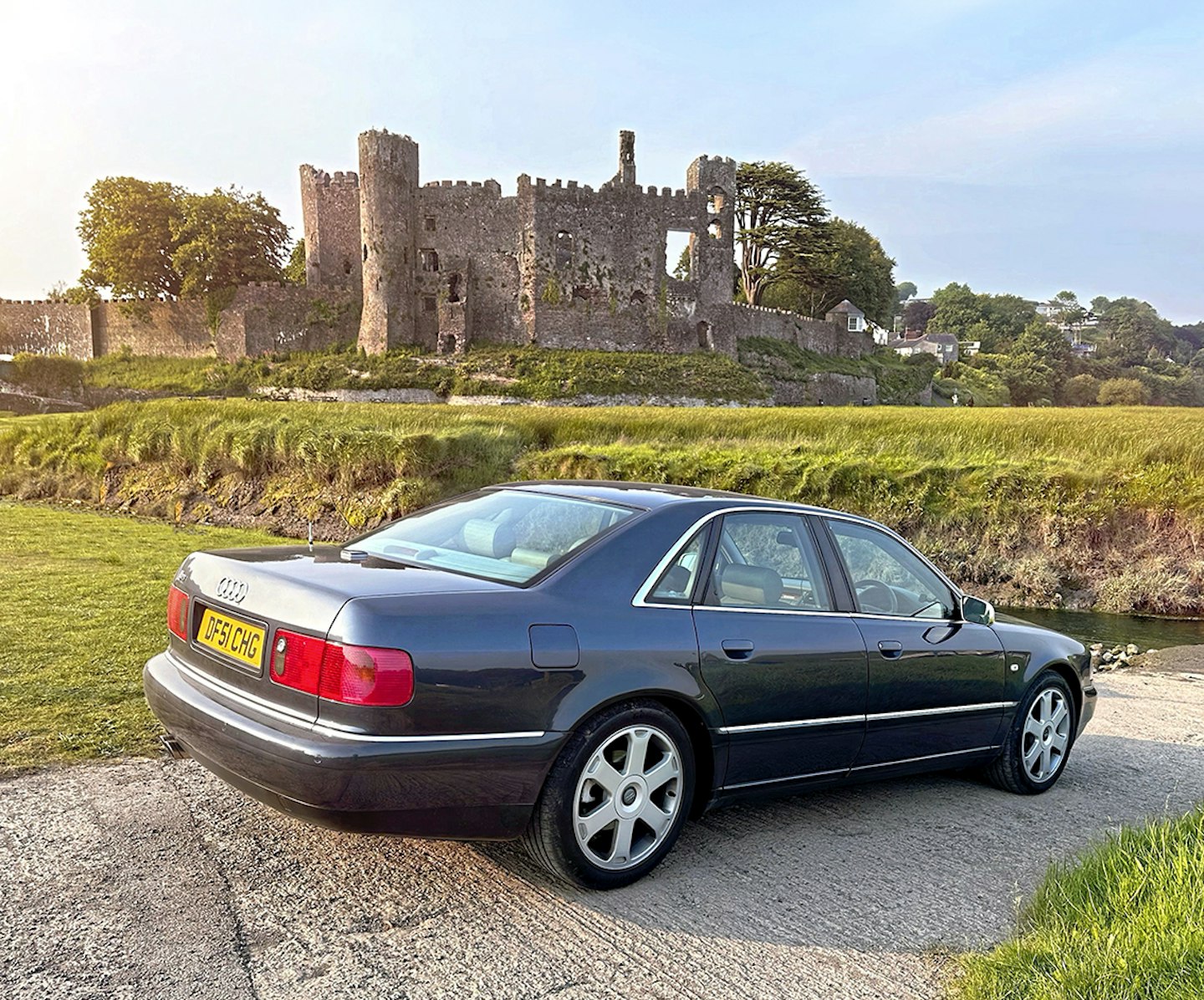TEAM ADVENTURE
To mark its 30th birthday, we hypermile the hottest A8 from Wales to Scotland
WORDS & PICTURES JAMES WALSHE


With my current working fleet comprising one ageing but economical diesel and a pair of lightweight runabouts with tiny petrol engines, I’ve become something of a stranger to the filling station. The oil-burning Berlingo will travel more than 750 miles before the warning light flickers and whether I’m off to the shops or the Italian Riviera, both 2CV and Smart return figures of 50mpg or more.
This is perfect for my frequent long-distance runs, for as much as I quite like electric cars, the range anxiety you get with an EV is just as annoying as having to stop all the time to feed a hungry V12. What if you could have efficiency, range and power? Three decades ago, the boffins of Ingolstadt reckoned they had the answer; a lightweight all-aluminium luxury car capable of transporting passengers across continents on a piffling quantity of petrol.

To see if the Audi A8’s twelve long years of development was worthwhile, and to mark its 30th birthday, I’ve borrowed one from Audi’s heritage collection and will drive it from the annual Pembrokeshire Classic Car Club event in Wales to the John O’Groats Classic Car Show – 676 miles away – with the aim of getting as close to Audi’s claimed economy figures as I can. It’ll involve some restrained driving – something the editor fully supports as it means I won’t be blowing the magazine’s monthly budget on fuel expenses. Not such good news for him is that Audi can’t provide the most efficient of its early A8 models, so instead of the ‘ultra-efficient’ 1500kg 2.8-litre A8, I’m aboard a beefier eight-cylinder 4.2-litre ‘S8’. It’s clear that whichever lead-footed journalist was previously at the wheel cared little for economy, as the average consumption figure is currently reading a feeble 15.1mpg. Let’s see what we can do about that…
Welsh wonders
I forget the hypermiling for now and wander the sunny airfield at Carew where the Pembrokeshire Classic Car Club have once again pulled out all the stops with an astonishing variety of classics, each accompanied by an assortment of unique stories. ‘My Passat was owned by one-legged man from Merthyr Tydfil’ declares owner Stuart Gerrish. His 1979 VW is a rarity and, although looking a bit frilly around the edges, has just 47,000-miles behind it. According to Stuart, the Valleys gent who owned the car from new had to give up driving completely after losing his second leg. I make the most of a thorough viewing of this now rarest of family cars, as I haven’t seen one in decades and it’s unlikely that I’ll see another for some considerable time (there are just four examples left in the UK).
My late model ‘D2’ S8 – slotted in next to a 1937 Morris 8 – is largely ignored by the older visitors, but it’s certainly a hit with the under forties. Most want to see under the bonnet and talk about how fast it is. The Audi couldn’t be more of a contrast to Malcolm Powell’s Morris. ‘I prefer the older vehicles, but it’s nice to see younger people and younger classic cars.’ He’s here with his daughter Jeanette, who stands beside her Morris Minor.

‘It’s like driving a tank compared to my modern Vauxhall, but it’s so much fun – and it’s always nice to come here with my dad’. Malcolm’s Morris 8 is often seen locally ‘bouncing off the dial’ as he puts it. ‘You can do sixty, but you need a good tailwind. We’ve got plenty of wind around here!’
There’s no sign of a tight isobar today as the S8 cleaves effortlessly through a gentle summer breeze to nearby Llansteffan where, for a few nights, I gatecrash my parents’ holiday. A former Audi 100 driver himself, (of the Eighties variety), dad gives the Audi the nod of approval and reminds me of the S8’s role in that spectacular car chase sequence in the film Ronin – a scrap with a 6.9-litre Mercedes 450SEL and a Citroën XM V6 in the mountains above Nice. A few days later, I top up the tank and begin my gentle waft across Wales. The S8 is firm for a luxury saloon and, although you do feel the ridges and lumps, it’s never fidgety. There’s a real sense that such delicate use of my right foot is a real waste of the car’s performance prowess. I resist temptation to replicate Ronin, choosing instead to enjoy the sight of a lush green Carmarthenshire countryside bathed in sunshine. The A40 drops me just east of Llandovery for a stop at the ‘Mail Coach Pillar’ – part of the world’s first official anti-drink drive campaign. This stone roadside obelisk was erected in 1841 to warn stagecoach drivers of the dangers of boozing after Royal Mail driver Edward Jenkins, drunk at the reins, crashed his stagecoach ‘at full gallop’ while travelling between Gloucester and Carmarthen. His coach, along with five passengers, tumbled into a nearby ravine. Thankfully, all survived.
Border crossing
Mindful of oncoming stagecoaches on the scenic A483, I skim the edge of the Brecon Beacons and onwards to the village of Cilmeri, near Builth Wells – the location of another important granite monolith. This one commemorates Llywelyn ap Gruffudd, the last native prince of an independent Wales. Llywelyn was killed in 1282 when the troops of Edward I rocked up at the Battle of Orewin Bridge. Llywelyn’s demise ended the autonomy of Wales with his only child – a daughter called Gwenllian –ending up in confinement at a convent in Lincolnshire until her death in 1337 – childless, at the age of 54. Wales is a land so fizzing with gripping tales, it makes Game of Thrones look like Mary Poppins.
The roads aren’t bad here, either. The S8 serenely swoops from corner to corner through Ceredigion and Powys in the afternoon sun. The magic 20mpg figure arrives in the hills above Newtown where panoramic views to the west – Snowdonia just visible on the horizon – serve as a grand finale to this scenic leg. Through Welshpool at mile number 120 and the range display is now reading 330 miles. While my economy drive has doubtless been harmed by the lumpy bits of mid-Wales, the level terrain of Oswestry and Wrexham allows the low-slung S8’s aerodynamics and lightweight all-aluminium ‘Audi Space Frame’ to really come into play. Brainchild of the late Dr Ferdinand Piëch (Audi 100, Quattro and Bugatti Veyron among many others), he and his aerospace inspired team dialled low weight into the design when he signed off A8 development in 1982. The car may have been a leviathan at launch 14 years later but at 1500kg, its chassis was 40 percent lighter than an S-Class, yet 30 percent stiffer. By comparison, the current Audi A8 is almost two tonnes, a Tesla Model S is 2100kg and the current electric Mercedes EQS is 2480kg. No wonder the UK has a pothole problem.
The extra 200kg of bulk from my S8 version is offset to some degree by the effortless nature of the 335bhp V8 up front, which never seems to be working very hard. Merging with the northbound HGVs on a thankfully quiet M6, I cruise past Shap and enjoy a view to my left of the distant craggy Langdale Pikes silhouetted against a crimson sky. Soon after, I’m pulling over for some sleep at a service station motel near Gretna.
Scottish sausage
Thursday morning begins with a 65mph cruise on the M74, fuel gauge needle now sinking towards empty. I anticipate my first stop for fuel will be somewhere around Stirling which is handy, given my penchant for a good farm shop café. By the time I’m tucking into a fry-up at Broadslap Farm, I’ve topped up the Audi’s tank for the first time – that’s 435 miles from Pembroke to a Shell garage near Gleneagles. With the driver now also refuelled, I twist the key and the dash display announces a curiously ambitious range of 600 miles. A few hours later, approaching Inverness, the range has dropped back to 495-miles… the economy display is now approaching a very pleasing 25mpg.
The A9 snakes its way north, past the oil rigs of Cromarty Firth, hugging the coast all the way to Helmsdale. Fed up with a motorhome driver oblivious to the misery they’re causing behind, I turn left and wind my way up the A897 via Kinbrace where dramatic scenery begins to drain the fuel tank a bit quicker.
A vast expanse of blue sky is besieged with colossal rainclouds that skulk menacingly across this wild landscape. Suddenly, I’m catching my first glimpse of the ocean. Turning east onto the well-trodden route of the North Coast 500, I arrive at Dunnet to be greeted by beaming friends Tom and Phyllida Sayles. The evening chatter is accompanied by a whisky or two and, next morning, Tom and I set off for the short hop to the show at John O’ Groats. In contrast to a sunny Wales, the Scottish weather is doing its best to spoil the event but despite the mad flapping of marquees and candy floss being blown clean off their sticks, Mother Nature's fury is ignored. There are tractors, vintage motors and a great showing of modern classics – everyone is having a great time, including the owner of a… MkI Volkswagen Passat. I can barely believe my eyes. This one wasn’t owned by a one-legged man from Myrthr Tydfil but a chap on the Isle of Man, which is where Thrumster resident Martin Foyle picked it up in 2020. He says it’s an unrestored car with 37,000 miles. ‘It’s on the original exhaust!’
We spend the rest of the day being relentlessly battered by wind and rain, but nobody seems in the least bit concerned – least of all the bagpipers who heroically parp their pipes into the squall at regular intervals. Commentary is by chap known as ‘A.I. Willie’ who spends the day on the mic providing inside knowledge on each of the exhibitors. I seek to clarify his name with a volunteer, who reveals that ‘A.I.’ stands for Artificial Insemination. ‘Aye, he’ll be back to his day job later – he’s got seven cows to do after this.’
I’m delighted to spot an old friend entering the field – it’s Bluebell, the Standard Ten Practical Classics helped to rescue from a scrappage scheme some years ago. She’s now on display at the brilliant Halkirk Heritage & Vintage Motor Centre – a newly opened attraction full of classic cars and memorabilia inspired by local enthusiast, the late Edward Sutherland. Volunteer Chris Eyre says it’s going well. ‘We’re getting a lot of classic car clubs and touring groups stopping off here and most importantly, everyone is coming away with a big smile on their face!’
To be a classic car enthusiast in this part of the world requires a certain ingenuity. With Inverness 120 miles and three hours to the south, (double it for Edinburgh) classic car owners often find it easier to fix and fabricate themselves – learning new skills in the process. That’s evident when chatting to those who aren’t in the least bit daunted at the need to be self-sufficient. ‘It is the same if I need something for the house’ says Steve, a member of the Caithness & Sutherland Vintage and Classic Vehicle Club. ‘Ask around and you’ll find what you’re looking for, sometimes in a shed, sometimes in a neighbour’s field’.
Sailing south
After a few days exploring the area, I’m parked up at the most northerly point of mainland Britain, near Dunnet Head, and realise that I really don’t want to leave. The ever-hospitable Tom has introduced me to a band of friendly and fascinating enthusiasts, (all of whom you’ll read about in the coming months) with their astonishing stories. Others we’ll return to, once their restorations are complete, like James Mackay who shows us a 2001 Jaguar X-type, onto which he’s grafted the front and rear from a Humber.
I ask why. ‘Why not?’ he shrugs. We’ll definitely be returning to see him, along with John Anderson, who opens his garage door to a genuine Humber; a half-finished 1950 Super Snipe and one of 120 Tickford dropheads made. My final stop in Scotland is George Sutherland’s yard. He began at an early age building and restoring carriages.
‘I was always doing work on the croft, working in my father’s smithy or milking the cow – we never stopped working!’ George has admitted he isn’t sure how many classic cars he has accumulated but knows it’s probably time to count them.
‘I really ought to sell a car or two.’ As for the astonishing collection of historic carriages, he’s less sure. ‘I’d ideally like them to go to a local museum, but there are quite a few!’
I return to the sumptuous driver’s seat of the Audi – relieved I don’t have to put up with cart springs on dirt tracks like the passengers of George’s 1870 Parishioner’s Phaeton carriage… or endure the whiff of a horse’s bottom. My right foot continues to gently caress of the throttle as I swoop down the coast alongside a sparkling seascape. The range display now reads 100 miles and so the decision is made to refuel the other side of Inverness. However, the temptation of the Cairngorms is too great. I’ve never been to this part of Scotland before but there’ll be a petrol station somewhere in the hills, right? As the miles go by, the corners tighten and my speed increases with every bend. The Audi is extraordinarily agile – sharp steering and tenacious 4x4 grip coupled with a surprising light-footedness that makes it feel more like a hot hatch than a colossal barge.
Appropriately near Cock Bridge, there’s a ping from the dashboard. Zero range. I’m an idiot. Fifteen miles of heavenly Scottish tarmac has sent the numbers tumbling and were it not for the can of petrol in the boot, I’d be in serious peril. I pass Balmoral Castle and still nothing – despite the big fat zero on the range display. Some 430-miles after the last fill-up, I pull into Braemar filling station and wonder what could have been had I not foolishly floored it.
That night, having dispatched the rest of southern Scotland and northeast England in around six hours, I pull into the Old Swan Hotel at Harrogate. Classic Lodges’ Richard Smith arrives in his MGB and joins me for dinner under the spectacular glass ceiling of the dining room.
I reflect on the past 1500 miles, Richard suggesting that I must be a bit knackered, but I’m honestly not. I don’t feel even slightly fatigued – testament to a time when car makers were stretching themselves and the engineering budgets. We’re not talking about the techno-fluff of today’s screens and gadgets here, either; despite its Eighties roots, this benchmark model’s advanced aluminium space-frame is a masterclass in weight saving. It’s proof that lightness really matters. Given the comparably heavyweight nature of the modern car, the A8 is even more relevant today than it was 30 years ago.
THANKS TO
-
Audi Heritage, Audi.co.uk
-
Classic Lodges, classiclodges.co.uk
-
The Old Swan, Harrogate, 01423 500055
Subscribe to a PC Print+ Subscription today and you'll get instant digital access to this article PLUS FREE UK delivery so you'll never miss an issue again. With our festive offer, try your first 6 issues for £19.99.
